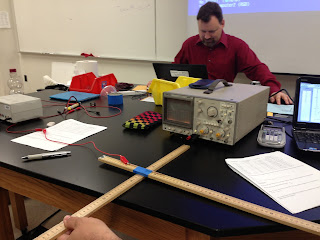Equipment:
- Light Source
- Semicircular Glass/Plastic Prism
- Circular Protractor
Experiment:
Tape the protractor to the desk oriented such that the light enters at 180 degrees and exits at 0 degrees. The initial setup is with the light entering perpendicular to flat side of the prism and exiting the curved side. The angle of incidence and the angle of refraction for the light ray in this configuration is 0 degrees. Nothing will happen to the light ray as it enters the prism from the air or enters the air from the prism since the light beam is hitting normal to the surface. This experiments covers a situation where the light will travl from low density to high density and then back to low density. Rotate the prism 10 degrees and record the angle of the light traveling through the prism. Continue to do this and record the values .
Below is the data table with these values.
Θ1
|
Θ2
|
sin(Θ1)
|
sin(Θ2)
|
0
|
0
|
0
|
0
|
10
|
4
|
0.1736482
|
0.0697565
|
20
|
8
|
0.3420201
|
0.1391731
|
30
|
12
|
0.5
|
0.2079117
|
40
|
15
|
0.6427876
|
0.258819
|
45
|
17
|
0.7071068
|
0.2923717
|
50
|
19
|
0.7660444
|
0.3255682
|
60
|
24
|
0.8660254
|
0.4067366
|
70
|
30
|
0.9396926
|
0.5
|
80
|
37
|
0.9848078
|
0.601815
|
Part 2 uses the same materials, however the prism will be roatated such that the light will enter on the circular side and exit the flat side. Locate the prism with the flat side perpendicular to the light source but on the opposite side. Similar to the photo shown below. As the light enters the prism it will pass striaght through without "bending" since the flat surface is normal to the light beam. This experiment again shows light traveling from low density to high denisty and back to low density. Rotate the prism 10 degrees, record the angle of the light beam and repeat.
Below is the data tables with these values.
Θ3
|
Θ4
|
sin(Θ3)
|
sin(Θ4)
|
0
|
0
|
0
|
0
|
10
|
5
|
0.173648
|
0.087156
|
15
|
8
|
0.258819
|
0.139173
|
20
|
12
|
0.34202
|
0.207912
|
25
|
13
|
0.422618
|
0.224951
|
30
|
15
|
0.5
|
0.258819
|
35
|
20
|
0.573576
|
0.34202
|
40
|
26
|
0.642788
|
0.438371
|
44
|
44
|
0.694658
|
0.694658
|
45
|
N/A
|
N/A
|
N/A
|
Conclusion:
In Part 1, the light would bend further and further as the prism rotated further around. Below is a plot of the graph of sin(Θ1) vs sin(Θ2). The trendline is y = 1.9944x.
In Part 2, the light would bend further and further as the prism rotated further around. Below is a plot of the graph of sin(Θ3) vs sin(Θ4). The trendline is y = 1.3346x.










